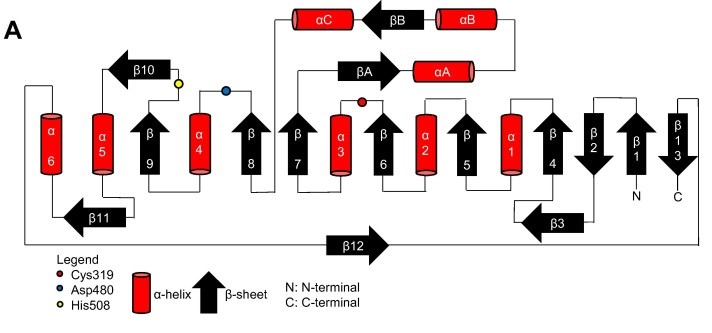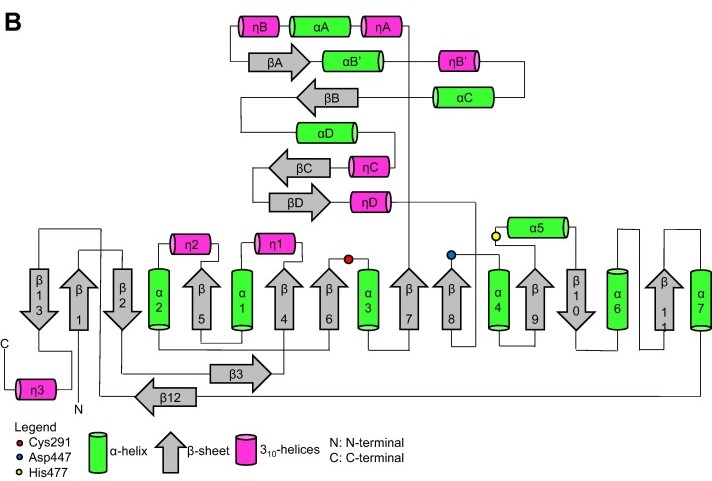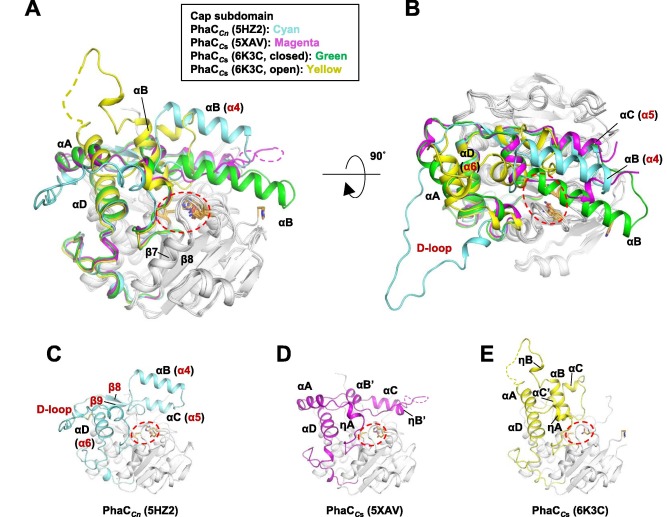User:Gustavo Sartorelli de Carvalho Rego/Sandbox 1
From Proteopedia
(Difference between revisions)
| Line 1: | Line 1: | ||
==Introduction== | ==Introduction== | ||
<StructureSection load='Crystal structure of PhaC1 from Ralstonia eutropha.pdb' size='350' side='right' caption='Crystal structure of PhaC1 from Ralstonia eutropha (PDB entry [[5HZ2]])' scene='10/1050300/Phac_class_i/1'> | <StructureSection load='Crystal structure of PhaC1 from Ralstonia eutropha.pdb' size='350' side='right' caption='Crystal structure of PhaC1 from Ralstonia eutropha (PDB entry [[5HZ2]])' scene='10/1050300/Phac_class_i/1'> | ||
| - | Poli 3-hydroxyalcanoates (PHA) are the main components of the cytoplasmatic inclusions, called PHA granules. They serve as carbon and energy reserves in many species of procariotes. PHA polymers can be made from different sized monomers, ranging from 4 to 14 carbon atoms. They are typically synthetized when there is an unbalanced distribution of nutrients in the medium, mainly an abundance of carbon sources coupled with the lack of another essential component. Among the existing PHAs, the most common are the poli-3-hydroxybutirate (PHB) polymers. | + | Poli 3-hydroxyalcanoates (PHA) are the main components of the cytoplasmatic inclusions, called PHA granules. They serve as carbon and energy reserves in many species of procariotes. PHA polymers can be made from different sized monomers, ranging from 4 to 14 carbon atoms. They are typically synthetized when there is an unbalanced distribution of nutrients in the medium, mainly an abundance of carbon sources coupled with the lack of another essential component. Among the existing PHAs, the most common are the poli-3-hydroxybutirate (PHB) polymers. <ref name='Barbosa'>BARBOSA, Heloiza Ramos; GOMEZ, José Gregório Cabrera; TORRES, Bayardo Baptista. Microbiologia básic - bacteriologia: bacteriologia. 2. ed. São Paulo: Editora Atheneu, 2018. 336 p.</ref>. PHBs are specially relevant due to their properties that resemble conventional plastics, such as polypropylene. Since they are biopolymers made from renewable, biodegrabable and compatible source materials, PHBs present themselves as an industrial alternative to petrol-based plastics.<ref name='Byron'>BYROM, D.. Polymer synthesis by micro- organisms: technology and economics. Tibtech, [s. l], v. 5, p. 246-250, set. 1987.</ref><ref name='Madison and Huisman'>MADISON, Lara L.; HUISMAN, Gjalt W.. Metabolic Engineering of Poly(3-Hydroxyalkanoates): From DNA to Plastic. Microbiology And Molecular Biology Reviews, Massachusetts, v. 1, n. 63, p. 21-53, mar. 1999.</ref> |
The polymerization of PHA monomers is performed by the PHA sintase/polymerase (phaC) enzyme. At first, two acetyl-CoA molecules are condensed into one acetoacetyl-CoA by a β-ketoacyl-CoA thiolase, and then reduced to (R)-3-hydroxybutyryl-CoA by the acetoacetyl-CoA dehydrogenase. Finally, phaC polymerizes the (R)-3-hydroxybutyryl-CoA molecules into the PHA polymer.<ref>Reddy, C.S.K, et al. “Polyhydroxyalkanoates: An Overview.” Bioresource Technology, vol. 87, no. 2, Apr. 2003, pp. 137–146, www.sciencedirect.com/science/article/pii/S0960852402002122, https://doi.org/10.1016/s0960-8524(02)00212-2.</ref> | The polymerization of PHA monomers is performed by the PHA sintase/polymerase (phaC) enzyme. At first, two acetyl-CoA molecules are condensed into one acetoacetyl-CoA by a β-ketoacyl-CoA thiolase, and then reduced to (R)-3-hydroxybutyryl-CoA by the acetoacetyl-CoA dehydrogenase. Finally, phaC polymerizes the (R)-3-hydroxybutyryl-CoA molecules into the PHA polymer.<ref>Reddy, C.S.K, et al. “Polyhydroxyalkanoates: An Overview.” Bioresource Technology, vol. 87, no. 2, Apr. 2003, pp. 137–146, www.sciencedirect.com/science/article/pii/S0960852402002122, https://doi.org/10.1016/s0960-8524(02)00212-2.</ref> | ||
Revision as of 14:50, 2 June 2024
Introduction
| |||||||||||



